This couldn't be a self respecting Antarctic web site without an entry on penguins and seals. These two kinds of animals are the most conspicuous and well known residents of Antarctica. Whales are another well known type of animal, but their numbers have been so decimated by whaling in the early part of this century that I only saw whales on three separate occasions.Birds and Seals of Antarctica
by David Krakowski and Isidro Bosch
Penguins are flightless birds are adapted to a life at sea. Their wings are used as flippers, and their bodies are designed to move easily underwater. They look quite clumsy on land, however, and watching the never-ending bustle of a nesting colony
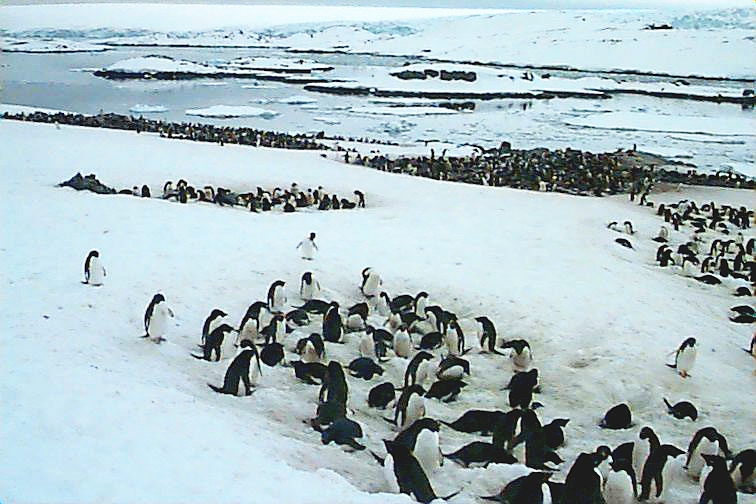 can
be likened to watching a real-life cartoon. Despite their apparently
ungainly appearance on land, penguins seem to have no problem negotiating
the most prohibitive terrain. They can come ashore at a wave
swept rocky beach and come out of the water unscathed. I have seen
penguins nesting on cliff sides, and I have seen penguins climbing hills
that I could barely scramble up. There is no doubt about a penguin's
grace in water. The penguin has been labeled as a "flightless" bird;
whoever made that description could not have ever observed penguins underwater.
Their fluid motion is awe-inspiring, they appear to dance with each other
in the water. They "porpoise" at the surface in groups, like so many
flying fish. Dr. Bosch has had the unique pleasure of swimming, both
SCUBA and snorkel with these animals.
can
be likened to watching a real-life cartoon. Despite their apparently
ungainly appearance on land, penguins seem to have no problem negotiating
the most prohibitive terrain. They can come ashore at a wave
swept rocky beach and come out of the water unscathed. I have seen
penguins nesting on cliff sides, and I have seen penguins climbing hills
that I could barely scramble up. There is no doubt about a penguin's
grace in water. The penguin has been labeled as a "flightless" bird;
whoever made that description could not have ever observed penguins underwater.
Their fluid motion is awe-inspiring, they appear to dance with each other
in the water. They "porpoise" at the surface in groups, like so many
flying fish. Dr. Bosch has had the unique pleasure of swimming, both
SCUBA and snorkel with these animals.
There are a number of species of penguins, each unique in appearance and/or
habits. Perhaps the most well known penguin is the emperor penguin.
The males of this species are renowned for their dedication to their young,
standing on the frozen ocean for three months during the brutal Antarctic
winter, without food, tending to a single egg that it holds on the top
of its feet tucked away under a fold of skin. 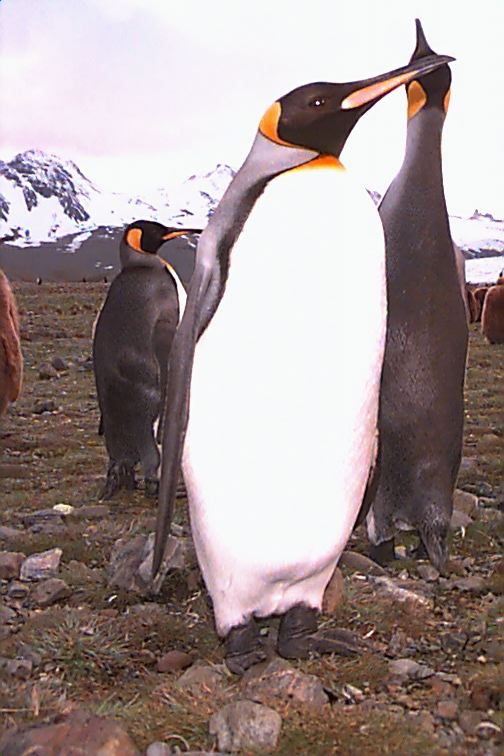
Most of the penguins we saw on and around Palmer Station were Adelie
penguins. These small penguins are the prototypical tuxedo waddling
little birds (image 6)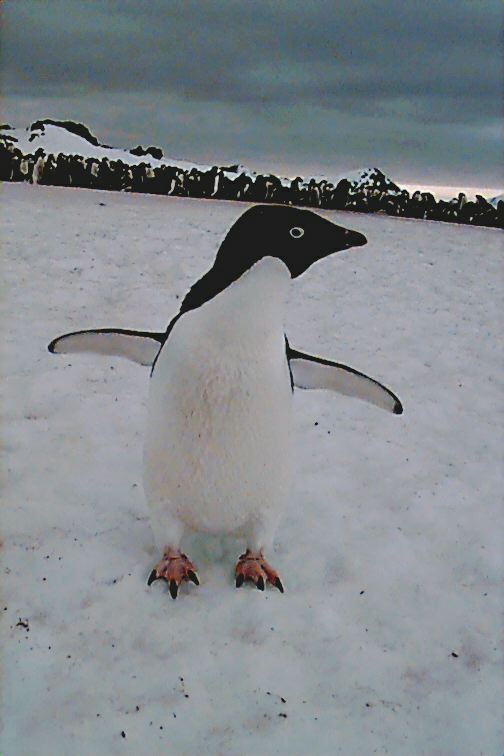
Related to the Adelie penguins are the chinstrap penguins (image
7), so named for obvious reasons, and the slightly larger gentoo penguins
(image 8). Gentoos are easily distinguished
from other penguins by their bright orange beak and white patches of feathers
that extend from above the eyes to the top of the head (image
9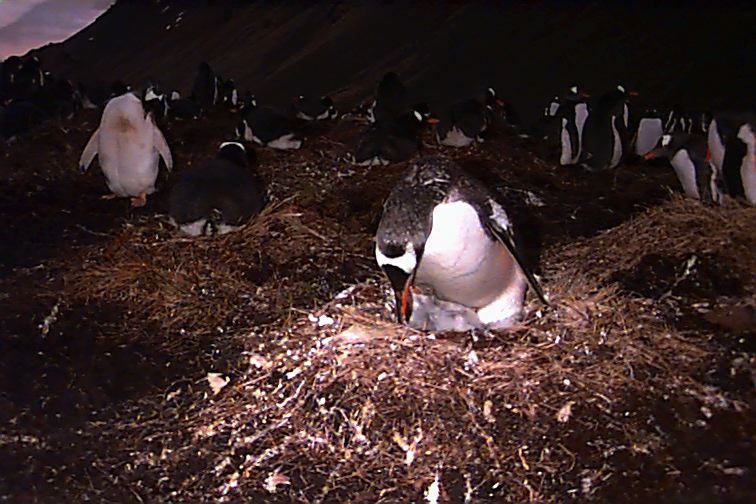
The macaroni penguin, with its yellow plumage above the eyes were so named by early British Antarctic explorers who were reminded of the ridiculous plumed hats worn by members of the famous Macaroni Club in London. They have been observed nesting on rocky cliffs (image 10) and in other seemingly inaccessible places. Their relative, the rockhopper penguin, is also fond of rocky cliffs as nesting sites. The rockhopper is quite a disagreeable little bird, and the rookery I visited was a continual cacophony of angry calls (image 11). They are also aptly named, and this became apparent to me as I watched one negotiate a pile of boulders.
Penguins live all over, but exclusively in the southern hemisphere of the
planet, living as far north as the Galapagos Islands. In the Falkland
Islands I saw a species of penguins that is well known in South Africa
and Southern South America. The Magellanic penguin was the most timid
penguin I saw on my trip, living in burrows just below the ground (image
12), and promptly retreating there at the first sign of movement near
the burrow.
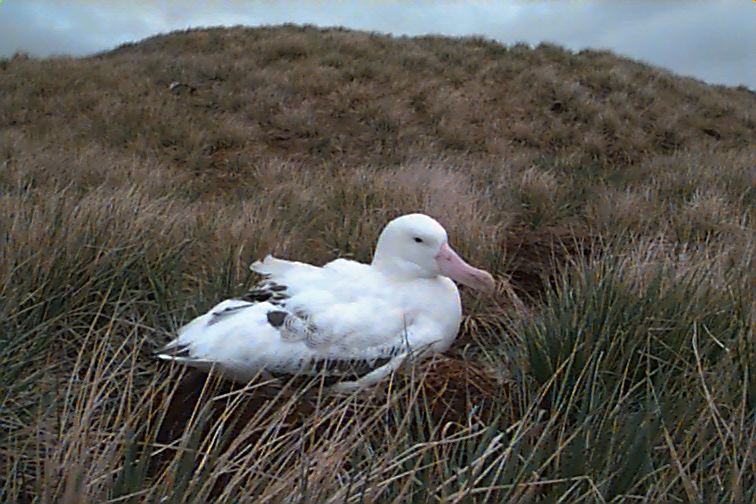
The seals are also conspicuous members of the Antarctic wildlife community.
There are a number of different species, all of which spend some or all
of the year in Antarctic waters. The most common seal is the crabeater
seal. In fact, the crabeater is the most common large mammal in the
world. It's title is a misnomer, as there are no known species of
crab in the Antarctic. The main prey item of the crabeater is krill.
Krill comprise a large portion of the diet of all the animals that I have
discussed thus far. All Antarctic penguins, whales, and seals rely
heavily, sometimes exclusively on krill as a food source. Crabeaters
rarely come ashore, and will occasionally haul out onto seaice. They
are hunted by killer whales and leopard seals, and many animals bear the
scars of previous encounters with these predators. The weddell seal
(image 16) 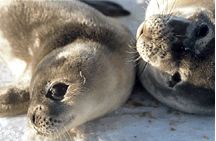
I saw many southern elephant seals (image 17)
during my trip. These large animals would frequently haul out to
pup or bask in the springtime sun. The males were simply enormous,
weighing up to five tons! They would compete with each other (image
18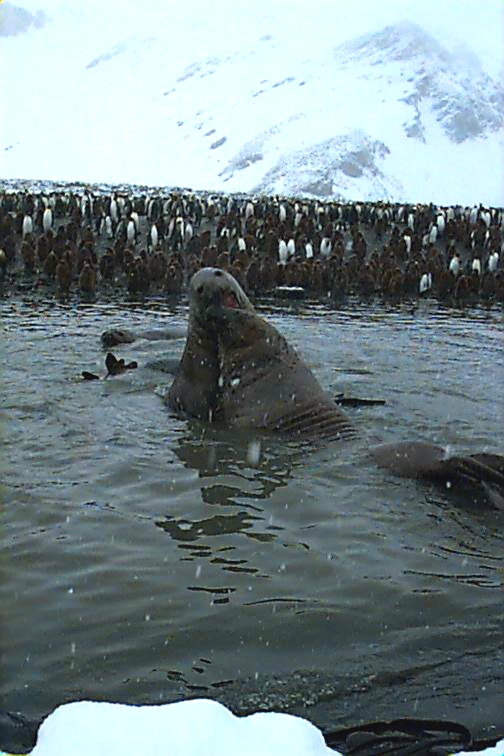
The leopard seal (image 19) is the most formidable of the seals. Although it, too, feeds on krill and squid, a main component of its diet is penguin and seal meat. Leopard seals will cruise off the coast of a penguin colony, waiting for an unsuspecting penguin, particularly an inexperienced juvenile, to enter the water. The leopard seal then pounces on its victim, flaying it by thrashing it against the surface of the water. Orcas are also known to do this to penguins. The leopard seal was of particular importance to us, as they are known to be aggressive towards divers (see the entry on Diving).
Finally there is the fur seal (image 20). Hunted nearly to extinction for it's pelt, populations have rebounded, shielded by the cessation of sealing in the early part of this century. Fur seals are related to sea lions, and can be differentiated from other seals by the presence of small ears (hence the scientific name Otorieds), and their ability to walk on their hind flippers. These seals are known to be aggressive towards man on land, primarily because we are seen as competition for mates. These animals will infest beaches as they form uneasy mating and pupping communities.
These are not the only species of seals and penguins in the Antarctic.
Ross seals are perhaps the least understood of Antarctic seals. Penguins
are numerous in species, ranging from the inner most reaches of the ice
shelves to more temperate regions of the southern hemisphere, particularly
the southern reaches of the southern continents. Unfortunately, I
did not have the opportunity to see all these animals, but it was a privilege
to see the species I did.
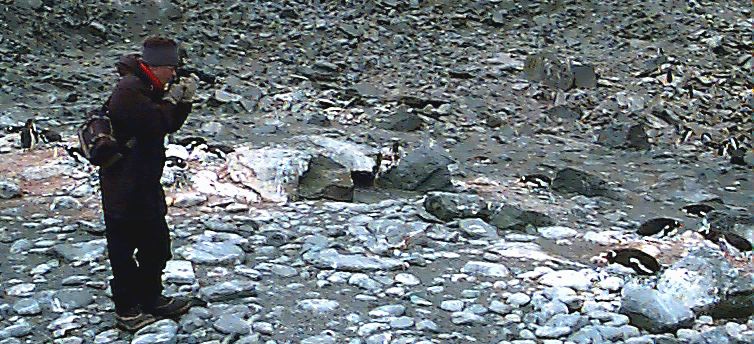 |
Dave photographing nesting gentoo penguins on Elephant Island, Antarctic Archipelago |